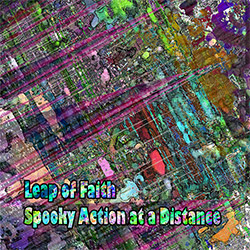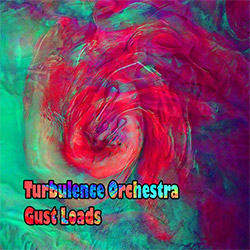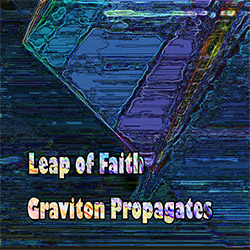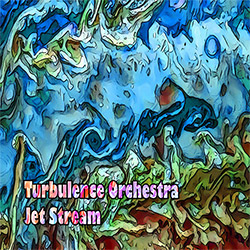![String Theory [Boston, USA]: Condensed Phases of Matter (Evil Clown) String Theory [Boston, USA]: Condensed Phases of Matter (Evil Clown)](https://www.teuthida.com/productImages/misc4/24780.jpg)
String Theory was formed as the string section for Boston's Leap of Faith Orchestra, the core being David Peck on reeds, game calls, fog horn, sirens, &c, and Glynis Lomon on cello, aquasonic and voice, with Jane Wang (cello) and Mimi Rabson (violin), creating a wonderfully assertive and somewhat skewed approach to improvisation, captured live at Mobius in Cambridge, 2016.
Out of Stock.
Quantity in Basket: None
Log In to use our Wish List
Shipping Weight: 5.00 units
Sample The Album:
David Peck (PEK)-clarinet, contra alto clarinet, sopranino saxophone, tenor saxphone, oboe, contra bassoon, sheng, aquasonic, game calls, fog horn, siren, whistles
Mimi Rabson-violin
Glynis Lomon-cello, aquasonic, voice
Jane Wang-cello
Click an artist name above to see in-stock items for that artist.
Label: Evil Clown
Catalog ID: 9111
Squidco Product Code: 24780
Format: CDR
Condition: New
Released: 2016
Country: USA
Packaging: Jewel Case
Recorded at Mobius,in Cambridge Massachusetts on June 24th, 2016.
String Theory was formed as the string section for Boston's Leap of Faith Orchestra, the core being David Peck on reeds, games calls, fog horn, sirens, &c, and Glynis Lomon on cello, aquasonic and voice, with Jane Wang (cello) and Mimi Rabson (violin), creating a wonderfully assertive and somewhat skew approach to improvisation, captured live at Mobius in Cambridge, 2016.
Artist Biographies
• Show Bio for David Peck (PEK) "PEK (aka David Peck) is a multi-instrument improviser who plays all kinds of instruments including saxophones, clarinets, double reeds, percussion, electronics and auxiliary sound making devices of all kinds. PEK was born in 1964 and started playing clarinet and piano in elementary school. In 7th grade he started saxophones, first on alto, then switching to tenor in high school. He spent 10 years playing in rock bands and studying classical and jazz saxophone with Kurt Heisig in the San Jose CA area before moving to Boston in 1989 to attend Berklee where he studied performance with George Garzone. While Berklee was an excellent place to study harmony, voice training and other important aspects of a conventional formal music training course of study, it was not a very good environment for learning contemporary (or pure) improvisation (apart from his work with George). PEK did find, however, that Boston had a thriving improvisation scene, and it was here that he developed his mature pure improvisation language. During the 90s, PEK performed with many notable improvisers including Masashi Harada, Glynis Lomon, William Parker, Laurence Cooke, Eric Zinman, Glenn Spearman, Raqib Hassan, Charlie Kohlhase, Steve Norton, Keith Hedger, Mark McGrain, Sydney Smart, Matt Samolis, Martha Ritchey, Larry Roland, Dennis Warren, Yuri Zbitnov, Craig Schildhauer, Keith Fullerton Whitman, Leslie Ross, Rob Bethel, Wayne Rogers, Eric Rosenthal, Taylor Ho Bynum, Tatsuya Nakatani, James Coleman, B'hob Rainey and George Garzone. PEK met cellist Glynis Lomon when they played together in the Masashi Harada Sextet which existed between 1990 and 1992. They developed a deep musical connection which they continued following the MHS; first with the Leaping Water Trio for a few years and then with the first version of Leap of Faith in 1994. Leap of Faith was very active in Boston from that time until 2001 and went through a series of several core ensembles which always included both PEK and Glynis. Other key Leap of Faith core members during this period were Mark McGrain (trombone), Craig Schildhauer (double bass), Sydney Smart (drums), Yuri Zbitnov (drums) and James Coleman (theremin). Leap of Faith was always a very modular unit with constantly shifting personnel and many different guests. The early Leap of Faith period concluded in 2001 with a dual bill at an excellent room at MIT called Killian Hall with George Garzone's seminal trio the Fringe. At this time, PEK changed careers for his day gig, returning to college for a computer science degree and beginning to work in the structural engineering industry at Simpson Gumpertz & Heger. He became far too busy to continue the heavy music schedule, and preferring not to do music casually, he entered a long musically dormant period. Flash forward to early 2014. PEK was a regular mail order customer of Downtown Music Gallery, the premiere specialty shop in Manhattan for free jazz, contemporary classical and other new music. While in New York on SGH business, he went down to DMG and had a lengthy conversation with proprietor Bruce Lee Gallanter about the early Leap of Faith period. He then sent Bruce a package of about 15 CD titles from the 90s and was pleasantly surprised when Bruce managed to sell nearly all of it. This public interest in the old catalog spurred PEK into getting back into performance. He reformed Leap of Faith with Glynis Lomon (cello, voice, aquasonic), Yuri Zbitnov (drums) and newcomer Steve Norton (clarinets and saxophones) and started to record and perform in early 2015. Now having access to financial resources always absent in the early period, PEK began to accumulate a huge collection of instruments both for himself and also to expand the palate of Leap of Faith and the other projects soon to follow. He acquired new recording equipment and many new saxophones, clarinets, double reeds, metal and wooden percussion instruments, electronic instruments, signal processing equipment and other sound-making devices from many cultures. He revived his old record label, Evil Clown, and created reissues and new releases for much of the early period work by Leap of Faith and many of his other projects to sell at shows, DMG and the internet (around 100 archival titles). The Arsenal of equipment has a grand purpose: To establish a large scale aesthetic problem to use the instruments to make long form broad palate improvisations with dramatic transformation and development. The very broad palate enables the long improvisations to evolve with very different movements and pronounced development over their length. PEK started the Leap of Faith Orchestra, a greatly expanded Leap of Faith, to achieve this purpose along with a number of smaller ensembles which are sub-units of the full orchestra including String Theory (focusing on orchestral strings), Metal Chaos Ensemble (focusing on metallic percussion), Turbulence (horn players), Mekaniks (electronics) and Chicxulub (space rock). In all, the Evil Clown roster includes over 40 musicians who contribute to one or more of the various projects, with PEK participating in all of them. Leap of Faith has also had some special guests like Steve Swell (trombone), Thomas Heberer (trumpet), Jeremiah Cymerman (clarinet) and Jim Hobbs (alto sax). The Leap of Faith Orchestra happens whenever several of these groups play together at the same time, or the ensemble exceeds 7 or 8 players. The Full Orchestra is a special case discussed below. The current roster is comprised in part of: - Core Leap of Faith: PEK, Glynis Lomon, Yuri Zbitnov (Steve Norton has since left to go to Graduate School) - Percussion: Andria Nicodemou (vibes), Kevin Dacey (perc), Joe Hartigan (perc), Syd Smart (drums) - Strings: Jane Wang (cello), Clara Kebabian (violin), Tony Leva (bass), Mimi Rabson (violin), Kirsten Lamb (bass), Brendan Higgins (bass), Silvain Castellano (bass), Rob Bethel (cello), Kit Demos (bass), Matt Scutchfield (violin), Helen Sherrah-Davies (violin) - Piano: Eric Zinman, Peter Cassino, Emilio Gonzales - Horns: Dave Harris (tuba, trombone), Charlie Kohlhase (saxes), Bob Moores (trumpet), Sara Honeywell (trombone), Forbes Graham (trumpet), John Baylies (tuba), Dan O'Brien (woodwinds), Zack Bartolomei (woodwinds), Kat Dobbins (trombone), Steve Provizer (trumpet, baritone horn), Matt Samolis (flute) - Electronics: Greg Grinnell, Jason Adams (electric bass, electronics) - Guitar: Dru Wesely, Grant Beale, Chris Florio - Voice: Dei Xhrist Evil Clown is documenting the ongoing solutions to this aesthetic challenge by creating limited CD editions and digital download albums of every performance and studio session by this array of ensembles. Interested audience can track the development of the grand scale project over the many releases - over 80 albums recorded and released so far between Jan of 2015 and March of 2017. All of the bands are highly modular, changing personnel and instrumentation with each meeting. The result is an enormous amount of music that shares the same fundamental improvisational language but differs from event to event greatly both in sonority (overall sound) and specific detail. For the full Leap of Faith Orchestra, PEK composes a graphic notation score to guide the improvisation. The full Orchestra is comprised of roughly 20 players from the roster and performs twice a year. Two performances have occurred to date - The Expanding Universe in June of 2016 and Supernovae in November of 2016. Composition for Possible Universes is completed and the work will be performed on May 28, 2017 with another performance (score not yet begun) scheduled for November. The scores use a device called Frame Notation where written English descriptions of the overall sonority desired and simple graphic symbols are given durations for each player on their part along with direction on when to play and when not to play. The directions are put in little boxes called frames which are arranged on a timeline and are simple enough to be immediately understood by the performers. Horizontal lines, called Duration Bars, extend across the page indicating when each Event (the Frame + the Duration Bar) begins and ends. An Event can be intended for the full ensemble, a defined group within the ensemble (for example, Metal Chaos Ensemble), a custom group (for example, Tubas), or an individual (for example, Andria Feature). Parts are the full score annotated with Hiliters so that each player's instructions stand out. They can clearly see their individual instructions, but can also see the big picture, enabling far more knowledge about the pending actions of the rest of the ensemble than typical in pure improvisation. The players track the elapsed time on a very large sports clock. There is no melodic, harmonic or rhythmic information specified. This system allows PEK to compose detailed Ensemble Events without having to notate pitches or rhythms which would require significant rehearsal to accurately achieve." ^ Hide Bio for David Peck (PEK) • Show Bio for Mimi Rabson "Mimi Rabson has distinguished herself as one of Boston's most creative and versatile musicians. She is a first-prize winner of the Massachusetts Cultural Council Fellowship in composition. Her compositions and arrangements are published by StringLetter Press (distributed by Hal Leonard). Her published works include arrangements of music by Duke Ellington, James Brown and Cole Porter as well as her originals. Her music and her articles frequent the pages of Strings Magazine. Her newest compositions include a formal string quartet performed and recorded by the Berklee Chamber Players and a string trio that offers classically trained musicians an outlet for improvisation. Ms. Rabson commissioned 6 fellow Berklee faculty members to compose new works for solo violin. Those works range in style from rock to hip hop and include contemporary practices like improvisation, interaction with computer and effects pedals. She used her electric violin in a power trio setting with electric bass and drums to record "Music", featuring noise-rock, post-jazz and electro-acoustic compositions and improvisations. Ms. Rabson created RESQ - the Really Eclectic String Quartet that plays her compositions and arrangements of jazz, funk, fusion, gospel and Latin music. That group produced two recordings. Ms. Rabson was a founding member of the Klezmer Conservatory Band and worked with that organization for many years touring, recording, composing and acting as musical director.Ms. Rabson appeared with Itzhak Perlman on the recording called "In the Fiddler's House" and on "The Late Show with David Letterman". She was featured in a documentary about Klezmer music called "A Jumpin' Night in the Garden of Eden". Ms. Rabson served as musical director to academy award winner, Joel Grey in his production of "Borschtcapades '94". Her composition "Klezzified" was featured on Saturday Night Live. Ms. Rabson's other performance credits include the premiere of "Fresh Faust" by Leroy Jenkins, soundtrack for "Sensorium"- the award winning film by Karen Aqua, with Robert Plant and Jimmy Page, Stevie Wonder, Meatloaf, Kristin Chenoweth, the Boston Gay Men's Choir, the Boston Camarata, the New England Ragtime Ensemble, the Klezmatics, Deborah Henson-Conant, the Pablo Ablanedo Octet, and XLCR. She has appeared on A Prairie Home Companion twice, at Avery Fisher Hall, Lincoln Center Out of Doors, Wolf Trap, the Mann Center, the Place des Arts in Montreal and other world class venues. Ms. Rabson is a sought after clinician. She has presented at The Mark O'Connor Fiddle Camp, ASTA, and numerous schools and colleges. Ms. Rabson has had compositions played by the Jazz Composers Alliance. Ms. Rabson is an Associate Professor at the Berklee College of Music and has received several Berklee grants to support her creative endeavors. She is a Yamaha String Educator." ^ Hide Bio for Mimi Rabson • Show Bio for Glynis Lomon "Improvising cellist, vocalist and aquasonic player Glynis Lomon graduated from Bennington College in 1975 with a degree in Music/Black Music. At Bennington she studied with musician/composer Bill Dixon and continued to perform and record with his ensembles until his recent death. Glynis has also been privileged to play with Arthur Brooks, Jimmy Lyons, Cecil Taylor, Butch Morris, William Parker, Joe Morris, Greta Buck, Masashi Harada, Lowell Davidson, Raqib Hassan and many others. For almost a decade she and multi reed player PEK performed in the Boston area with their group Leap of Faith." ^ Hide Bio for Glynis Lomon • Show Bio for Jane Wang "Composer/multi-instrumentalist/multimedia artist Jane Wang develops and curates/co-curates work in the disciplines of installation art, fluxus, musical instrument construction, performance art, video. Her works have shown at the 2009 Open Performance Art Festival (Beijing), Fluxhibition 3, A Book About Death (NYC), various happenings by Matthew Lee Knowles (UK). She curated the 2012 six month series: the art of the UnGrand and continues to curate the ongoing mobius blogs and open calls for work: Signs of Our Times and The Prostitution of Art. She composed and performed scores for her long-time collaborator performance artist Hanne Tierney, playwright Renita Martin, conceptual artistJason Hendrik Hansma, choreographers Danny Swain, Liz Roncka, Yuka Takahashi. She has an ongoing artistic partnership with choreographer Nathan Andary with future projects planned for 2016 and beyond. Her sculptures knit from electrical wire have shown at Mobius, Zeroplan, The NY Fountain Art Fair 2011, and the group exhibition Forest, For the Trees. She received a 2013 Drama Desk Nomination for Outstanding Music in a Play for Hanne Tierney's Strange Tales of Liaozhaiwherein she performed on and built space places - the invention of Tom Nunn." ^ Hide Bio for Jane Wang
11/20/2024
Have a better biography or biography source? Please Contact Us so that we can update this biography.
11/20/2024
Have a better biography or biography source? Please Contact Us so that we can update this biography.
11/20/2024
Have a better biography or biography source? Please Contact Us so that we can update this biography.
11/20/2024
Have a better biography or biography source? Please Contact Us so that we can update this biography.
Track Listing:
1. Condensed Phases of Matter 01:10:20
Improvised Music
Free Improvisation
Boston Area Improvisers
Quartet Recordings
Stringed Instruments
Search for other titles on the label:
Evil Clown.


![String Theory [Boston, USA]: Condensed Phases of Matter (Evil Clown) String Theory [Boston, USA]: Condensed Phases of Matter (Evil Clown)](https://www.teuthida.com/productImages/full/24780.Full.jpg)
























![Guy, Barry / Ken Vandermark: Occasional Poems [2 CDs]](https://www.teuthida.com/productImages/misc4/34849.jpg)
![Novoa / Carter / Mela Trio: Vol.1 [VINYL]](https://www.teuthida.com/productImages/misc4/35236.jpg)


![Elephant9 : Mythical River [VINYL]](https://www.teuthida.com/productImages/misc4/34624.jpg)
![Evans, Peter (Evans / Eldh / Black): Extra [VINYL]](https://www.teuthida.com/productImages/misc4/35279.jpg)

![McPhee, Joe: Straight Up, Without Wings [BOOK]](https://www.teuthida.com/productImages/misc4/35454.jpg)
![Jeck, Philip: rpm [2 CDs]](https://www.teuthida.com/productImages/misc4/35455.jpg)









![Barker / Parker / Irabagon: Bakunawa [VINYL]](https://www.teuthida.com/productImages/misc4/35533.jpg)
![Blaser, Samuel / Marc Ducret / Peter Bruun: Dark Was The Night, Cold Was The Ground [VINYL 10-inch]](https://www.teuthida.com/productImages/misc4/35492.jpg)






![Warren, Kenny (Warren / Hoffman / Ellman): Sweet World [VINYL]](https://www.teuthida.com/productImages/misc4/35451.jpg)




![Blake, Ran / Dave Knife Fabris: Live Amsterdam 2006, First Visit [CD + POSTCARDS]](https://www.teuthida.com/productImages/misc4/35275.jpg)













![DNS: Taking Big Bites Of The Khandas Three Cafes Deep [2 CDs]](https://www.teuthida.com/productImages/misc4/35334.jpg)




![Cleaver, Gerald: The Process [VINYL]](https://www.teuthida.com/productImages/misc4/34966.jpg)




![Alva Noto: HYbr:ID II [VINYL 2 LPs]](https://www.teuthida.com/productImages/misc4/35201.jpg)

![Baron, Derek / Luke Martin: Distinct and Concealed [CASSETTE + DOWNLOAD]](https://www.teuthida.com/productImages/misc4/35079.jpg)

![Lyle, Erica Dawn : Colonial Motels [CASSETTE + DOWNLOAD]](https://www.teuthida.com/productImages/misc4/35080.jpg)









![Sanna, Claudio: Compositori Sardi Contemporanei II [2 CDs]](https://www.teuthida.com/productImages/misc4/35317.jpg)







![Zurria, Manuel: Fame di Vento [3 CDs]](https://www.teuthida.com/productImages/misc4/35167.jpg)

![Granberg, Magnus / Nattens Inbrott / Skogen: Holde Traume, Kehret Wieder! [2 CDs]](https://www.teuthida.com/productImages/misc4/35038.jpg)
![Frey, Jurg: Outermost Melodie [2 CDs]](https://www.teuthida.com/productImages/misc4/35039.jpg)

![Pavone, Jessica: Reverse Bloom [VINYL]](https://www.teuthida.com/productImages/misc4/34895.jpg)




![Modney (Modney / Wooley / Gentile / Roberts / Pluta / Symthe / ...): Ascending Primes [2 CDs]](https://www.teuthida.com/productImages/misc4/34852.jpg)









![Elephant9 with Terje Rypdal: Catching Fire [VINYL 2 LPs]](https://www.teuthida.com/productImages/misc4/35355.jpg)
![Deerlady (Obomsawin, Mali / Magdalena Abrego): Greatest Hits [VINYL]](https://www.teuthida.com/productImages/misc4/34876.jpg)




![Haino, Keiji: Black Blues [2 CDs]](https://www.teuthida.com/productImages/misc4/35109.jpg)



![Surplus 1980: Illusion of Consistency [CD]](https://www.teuthida.com/productImages/misc4/35069.jpg)
![Staiano, Moe: Away Towards the Light [VINYL + DOWNLOAD]](https://www.teuthida.com/productImages/misc4/35037.jpg)



![Caveira (Gomes / Sousa / Abras / Ferrandini): Ficar Vivo [VINYL]](https://www.teuthida.com/productImages/misc4/34643.jpg)
![Gregg, J. J. / David Van Auken: Lunar Prairie [CD w/ DOWNLOAD]](https://www.teuthida.com/productImages/misc4/34611.jpg)

![Coultrain: Mundus [VINYL]](https://www.teuthida.com/productImages/misc4/32439.jpg)
![Mattin: Songbook #6 [VINYL]](https://www.teuthida.com/productImages/misc4/27317.jpg)
![Punkappella: Wake Up [7-inch VINYL]](https://www.teuthida.com/productImages/misc4/17519.jpg)
![Residents, The: WARNING: UNiNC.: Live And Experimental Recordings 1971-1972 [VINYL 2 LPs]](https://www.teuthida.com/productImages/misc4/31521.jpg)
![Coultrain: Phantasmagoria [VINYL]](https://www.teuthida.com/productImages/misc4/30142.jpg)
![Lennon, Sean Ono: Asterisms [VINYL]](https://www.teuthida.com/productImages/misc4/34517.jpg)

![Coley, Byron: Dating Tips for Touring Bands [VINYL]](https://www.teuthida.com/productImages/misc4/17906.jpg)

![Lost Kisses: My Life is Sad & Funny [DVD]](https://www.teuthida.com/productImages/misc4/lostKissesDVD.jpg)